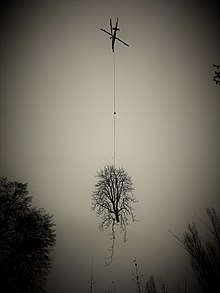
In the United States, national forest is a classification of protected and managed federal lands that are largely forest and woodland areas. They are owned collectively by the American people through the federal government and managed by the United States Forest Service, a division of the United States Department of Agriculture. The U.S. Forest Service is also a forestry research organization which provides financial assistance to state and local forestry industry. There are 154 national forests in the United States.

Logging is the process of cutting, processing, and moving trees to a location for transport. It may include skidding, on-site processing, and loading of trees or logs onto trucks or skeleton cars. In forestry, the term logging is sometimes used narrowly to describe the logistics of moving wood from the stump to somewhere outside the forest, usually a sawmill or a lumber yard. In common usage, however, the term may cover a range of forestry or silviculture activities.

Cut-to-length logging (CTL) is a mechanized harvesting system in which trees are delimbed and cut to length directly at the stump. CTL is typically a two-man, two-machine operation with a harvester felling, delimbing, and bucking trees and a forwarder transporting the logs from the felling to a landing area close to a road accessible by trucks.

Thinning is a term used in agricultural sciences to mean the removal of some plants, or parts of plants, to make room for the growth of others. Selective removal of parts of a plant such as branches, buds, or roots is typically known as pruning.
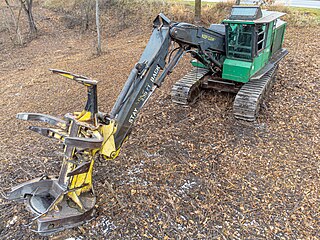
A feller buncher is a type of harvester used in logging. It is a motorized vehicle with an attachment that can rapidly gather and cut a tree before felling it.
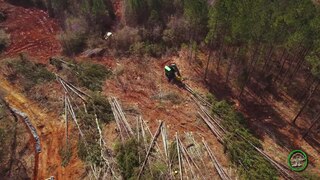
A harvester is a type of heavy forestry vehicle employed in cut-to-length logging operations for felling, delimbing and bucking trees. A forest harvester is typically employed together with a forwarder that hauls the logs to a roadside landing.
Silviculture is the practice of controlling the growth, composition/structure, as well as quality of forests to meet values and needs, specifically timber production.

An old-growth forest is a forest that has developed over a long period of time without disturbance. Due to this, old-growth forests exhibit unique ecological features. The Food and Agriculture Organization of the United Nations defines primary forests as naturally regenerated forests of native tree species where there are no clearly visible indications of human activity and the ecological processes are not significantly disturbed. One-third of the world's forests are primary forests. Old-growth features include diverse tree-related structures that provide diverse wildlife habitats that increases the biodiversity of the forested ecosystem. Virgin or first-growth forests are old-growth forests that have never been logged. The concept of diverse tree structure includes multi-layered canopies and canopy gaps, greatly varying tree heights and diameters, and diverse tree species and classes and sizes of woody debris.

Clearcutting, clearfelling or clearcut logging is a forestry/logging practice in which most or all trees in an area are uniformly cut down. Along with shelterwood and seed tree harvests, it is used by foresters to create certain types of forest ecosystems and to promote select species that require an abundance of sunlight or grow in large, even-age stands. Logging companies and forest-worker unions in some countries support the practice for scientific, safety and economic reasons, while detractors consider it a form of deforestation that destroys natural habitats and contributes to climate change. Environmentalists, traditional owners, local residents and others have regularly campaigned against clearcutting, including through the use of blockades and nonviolent direct action.
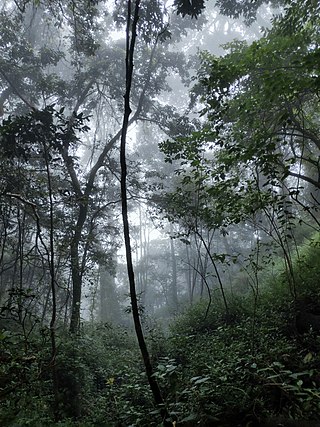
Sustainable forest management (SFM) is the management of forests according to the principles of sustainable development. Sustainable forest management has to keep the balance between three main pillars: ecological, economic and socio-cultural. The goal of sustainable forestry is to allow for a balance to be found between making use of trees and also maintaining natural patterns of disturbance and regeneration. The forestry industry mitigates climate change by boosting carbon storage in growing trees and soils and improving the sustainable supply of renewable raw materials via sustainable forest management.
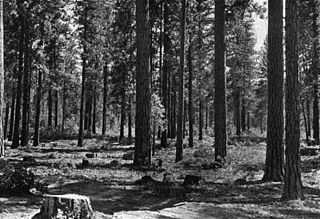
Selection cutting, also known as selection system, is the silvicultural practice of harvesting trees in a way that moves a forest stand towards an uneven-aged or all-aged condition, or 'structure'. Using stocking models derived from the study of old growth forests, selection cutting, also known as 'selection system', or 'selection silviculture', manages the establishment, continued growth and final harvest of multiple age classes of trees within a stand. A closely related approach to forest management is Continuous Cover Forestry (CCF), which makes use of selection systems to achieve a permanently irregular stand structure.
The following outline is provided as an overview of and guide to forestry:
Underwater logging is the process of logging trees from underwater forests. When artificial reservoirs and dams are built, large areas of forest are often inundated; although the trees die, the wood is often preserved. The trees can then be felled using special underwater machinery and floated up to the surface. One such machine is the sawfish harvester. There is an ongoing debate to determine whether or not underwater logging is a sustainable practice and if it is more environmentally sustainable than traditional logging.
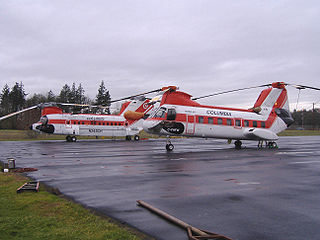
Columbia Helicopters, Incorporated (CHI) is an aircraft manufacturing and operator company based in Aurora, Oregon, United States. It is known for operating tandem rotor helicopters; in present times, exclusively the Boeing Vertol 107 and Boeing Vertol 234. These helicopters are used in stream restoration and forestry, including heli-logging, aerial firefighting, oil exploration, construction, government support, film production, disaster response, and many other activities. In addition, the company operates a large FAA repair station supporting customers worldwide.
Variable retention is a relatively new silvicultural system that retains forest structural elements for at least one rotation in order to preserve environmental values associated with structurally complex forests.
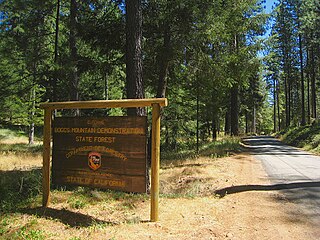
Boggs Mountain Demonstration State Forest is a state forest in Lake County, California that covers the northwest of Boggs Mountain. It was founded in 1949, and came into operation in 1950 when most of the site had been clear cut. The purpose was to demonstrate good practices in restoring and managing a forest. The state forest was open for recreational use, including camping, hiking, mountain biking etc. The 2015 Valley Fire destroyed 80% of the trees. The state forest as of 2021 was replanting saplings.

A cargo hook is a device suspended below a helicopter and allows the transport of external loads during flight. Common terms for this operation include slingwork, underslung loads, external loadwork, and external load operations.
Selective logging or partial forest removal is the practice of cutting down a few species of trees while leaving the rest intact and unharmed. Selective logging is often considered a better alternative to clear cutting. Selective logging in the Brazilian Amazon Rainforest was recently shown in analyses of Landsat Enhanced Thematic Mapper Plus data at high spatial resolution to be occurring at rates of about 12,000–20,000 km2 per year, thus indicating the central role of selective logging in tropical forest disturbance. Although selective logging has far less impact on forest processes than deforestation, selectively logged sites have higher rates of forest fires, tree fall, changes in microclimate, soil compaction and erosion, among other ecological impacts on biodiversity and ecosystem functioning.

Continuous cover forestry is an approach to the sustainable management of forests whereby forest stands are maintained in a permanently irregular structure, which is created and sustained through the selection and harvesting of individual trees. The term "continuous cover forestry" does not equate exactly to any one particular silvicultural system, but is typified by selection systems. For example, coppice with standards and Reiniger's target diameter harvesting are also continuous cover forestry. Different existing forest stands may require different silvicultural interventions to achieve a continuously productive irregular structure. Crucially, clearcutting and other rotational forest management systems are avoided.
The wood industry or timber industry is the industry concerned with forestry, logging, timber trade, and the production of primary forest products and wood products and secondary products like wood pulp for the pulp and paper industry. Some of the largest producers are also among the biggest owners of timberland. The wood industry has historically been and continues to be an important sector in many economies.

